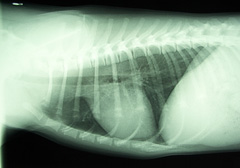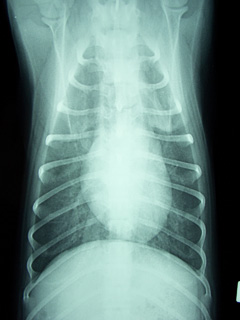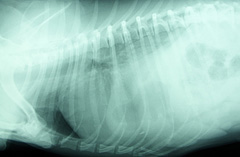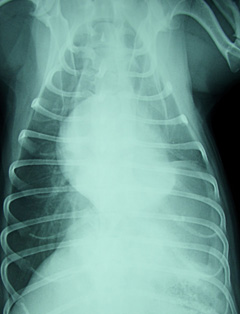The diaphragm is the muscular separation between the chest and abdominal cavities that functions as a barrier and aids in respiration. Diaphragmatic hernia is the disruption of the diaphragm which allows abdominal organs to migrate into the chest cavity. Frequently, diaphragmatic hernias occur in conjunction with a traumatic event, such as being hit by a car; these animals can have multiple traumas that require medical attention.
Two types of diaphragmatic hernias occur in dogs and cats:
- Traumatic ̶ caused by an event that tears the diaphragm
- Congenital ̶ pets have these at birth (The most common type of this subcategory is the peritoneal-pericardial diaphragmatic hernia (PPDH).)
A diaphragmatic hernia can cause significant respiratory difficulty. The trauma that caused the hernia may also result in rib fractures, lung lacerations, and lung bruising. These injuries may lead to pneumothorax (air in the chest outside the lungs), or hemothorax (blood in the chest cavity). If abdominal contents have entered the chest cavity, this can further compromise the ability to expand the lungs. Abdominal organs, displaced through a diaphragmatic hernia, may experience compromise to their blood supply.
Signs associated with an acute diaphragmatic hernia are usually related to difficulty expanding the lungs with the additional contents in the chest. Signs observed include:
- difficulty breathing
- rapid, shallow breathing pattern
- abnormal breathing posture with extended head and neck
If the initial insult is tolerated, a diaphragmatic hernia may be diagnosed later in life. Over time, abdominal organs, such as the liver or intestines, can become adhered in the chest cavity and your pet may exhibit signs associated with liver or gastrointestinal disease such as vomiting or anorexia.

Chest radiographs must be taken to diagnose the disease, and to look for any other abnormalities. In the normal animal, a diaphragmatic line, a cardiac silhouette, and air-filled lung fields are appreciated on chest radiographs (Figures 1 and 2). In the case of diaphragmatic hernia, loss of the diaphragmatic line, loss of the cardiac silhouette, displacement of lung fields, and presence of abdominal contents within the chest cavity may be noted on chest radiographs (Figures 3 and 4).
Your primary care veterinarian may request additional imaging tests to include:
- abdominal and thoracic ultrasound
- contrast radiography (taking radiographs after placing a contrast medium in gastrointestinal system)
- computed tomography (CT scan)



The only treatment to repair the diaphragmatic hernia is surgery. Surgical treatment should be performed as soon as your pet is stable for general anesthesia. Some patients with profound respiratory distress will not breathe comfortably until the abdominal contents are removed. Surgery is performed on an emergency basis if the stomach is herniated into the chest cavity and becomes distended with gas. This can prevent lung expansion and cause respiratory distress. A needle can be passed through the chest wall into the stomach to decompress the stomach, and then surgery can be performed. Surgical repair of the diaphragmatic hernia is typically performed by entering the abdominal cavity along the ventral midline, retracting the abdominal organs back into the abdomen, and suturing the tear in the diaphragm. A tube may be placed to remove air, blood, or fluid that may accumulate in the chest cavity. Your veterinarian may refer you and your pet to an ACVS board-certified veterinary surgeon for this procedure.
Some patients may need a portion of an abdominal organ (liver, gall bladder, spleen, stomach or small intestine removed if the blood supply has been compromised. Each of these procedures has its own set of risks and complications. If the herniation is chronic and adhesions (attachments between organs with scar tissue) have formed, bleeding may be a complication in surgery.
A hospital stay will be required after surgery. Tubes placed during the procedure, such as for fluid removal or feeding, may need to stay in place for a couple of days. Many of these pets may have suffered additional injuries that also require a hospital stay. Pain management is a big part of the animal’s recovery and is best managed in a hospital setting.
Most animals will begin to feel better after surgery and will want to be active. It is important to encourage rest and avoid activity during the post-operative period.
The prognosis for animals presenting with a traumatic diaphragmatic hernia is variable depending on other injuries incurred. It is estimated that roughly 15% of animals suffering traumatic diaphragmatic hernia will die before presentation. Successful treatment of shock prior to surgery results in the best survival rates. Animals having surgery greater than one year after the initial insult may have a worse prognosis due to the presence of adhesions (fibrous attachments) to other organs or tissues.
The mortality rate for dogs and cats having surgery for congenital hernias (PPDH) is low and the prognosis for return to normal function and performance is excellent.













